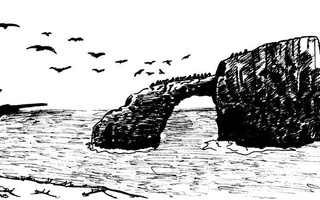Jonathan B. Losos ’84, professor of Organismic and Evolutionary Biology and curator of the Museum of Comparative Zoology, spoke about the relevance of islands to the study of evolution at the Geological Lecture Hall on Thursday evening.
This presentation preceded a special preview of “Islands: Evolving in Isolation," a new exhibit which will be on display at the Harvard Museum of Natural History beginning Saturday. Janis Sacco, director of exhibitions for the Harvard Museums of Science and Culture, spearheaded the creation of the exhibit, which Losos also advised from inception to realization.
At the event, Losos emphasized the integral role of islands to the study of evolutionary biology, citing as an example the way that Charles Darwin pooled evidence from species on the Galapagos Islands to support his theory of evolution by natural selection.
“We don’t study islands because we are interested in evolution on islands,” Losos said. “We study islands because they are a particularly good place to understand evolution in general.”
The small scale of island ecosystems allows for greater insight into evolutionary patterns exhibited therein, Losos said. He spoke about islands’ ability to serve as “nature’s test tubes of evolution” by illustrating what evolution is capable of in very diverse environments.
Attendees of the event said they were drawn to the talk for reasons ranging from an interest in evolution on islands, the new exhibit’s unveiling, and Losos’s notoriety as an influential researcher in the field of evolutionary biology, with his specific research involving evolutionary radiation of Caribbean Anolis lizards.
“Seeing how the ideas about diversity are generated from isolated populations that undergo their own selection events from certain traits in the environment is really cool,” said Jasmin Camacho, who is pursuing a Ph.D. in Organismic and Evolutionary Biology.
The exhibit is designed to reflect many of the themes that Losos discussed, including the depiction of complex intersections of biodiversity and evolution, which use a vast array of plant and animal specimens from islands across the globe.
“The novel thing about it is putting all these examples together in one place, and taking advantage of the great specimen collection that we have to illustrate these processes,” Losos said.
Read more in Faculty News
Theater Concentration Begins Hiring FacultyRecommended Articles
-
INTERESTING UNION LECTUREMr. W. Cameron Forbes '92, vice-governor of the Philippines and secretary of commerce and police at Manila, delivered an interesting
-
QUEZON REQUESTS INDEPENDENCE OF THE PHILIPPINESDispelling most of the reasons yet propounded for the further retention of the Philippine Islands by the United States, Manuel
-
MIT Student’s Body Recovered DrownedThe body of a fifth-year undergraduate MIT student who had been missing for nearly two weeks was found washed ashore
-
 Boyle Predicts a Dark Future 'When the Killing's Done'
Boyle Predicts a Dark Future 'When the Killing's Done' -
Not Your Island ParadiseI have a lot to be thankful for—unlike many of my friends from home, my parents are not part of the 32 percent of the CNMI’s population who may lose their legal status on Nov. 28.
-
 Daylight Saving Time
Daylight Saving Time













